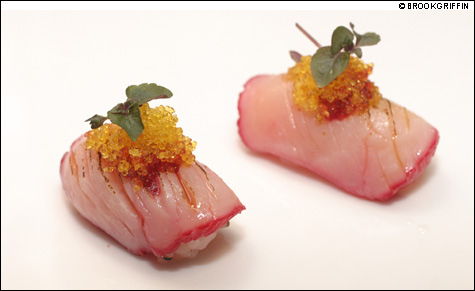
YOU GET WHAT YOU PAY FOR: At O Ya, the prices are high and the food measures up.
|
This is the New York–iest restaurant we’ve ever had in Boston, and it’s not for the faint of wallet. It’s smaller, more creative, and more truly postmodern than Oishii Boston, but on that level. In fact, you may want to pop in for a small plate of sashimi and a glass of wine or sake just to check out the design, which has the industrial-chic flair of an old firehouse, stripped down to beams and walls. There’s enough steel and concrete to make a music video, but an array of pebbles, orchids, and ikebana keep up the Asian theme. The only problem is finding the door. It’s around the corner, in an alley.
Once inside, we started with wild ivory king salmon ($18) and Santa Barbara sea urchin ($23) sashimi. The first was one of the better sashimi I’ve tasted. As a cooked fish, ivory salmon is lean. But served raw, it’s even richer in texture than some tuna. The sea-urchin-roe sashimi, a bland seafood to begin with, was plumped up with sea-urchin mousse, which is also pretty bland and hard to pick up, even with a fork. Adding flavor were bits of fried shiso leaves (a strong citric herb) and fresh tarragon. Still, this is a tiny plate for the price. Even sea-urchin fans will want to wait for the cheaper and fresher Maine product to return.
Another fine option is chilled daikon “dumplings” ($11): three micro tacos made from folded radish slices, each containing miso “cheese,” meaty-tasting wakame seaweed, a shred of homemade kimchee, and a spicy mayonnaise. The tastes complement each other surprisingly well, and its long rectangular glass platter is strewn with edible flowers and micro greens.
My favorite plate of the evening was grilled sashimi of chanterelles and shiitake mushrooms with sesame froth ($15). The chanterelles — delicate wild mushrooms that are often overwhelmed in restaurant dishes — were plump and delicious in this treatment. Likewise, the shiitake were not too chewy, and were served with sesame brittle and cracked black pepper, which added explosions of flavor along with the frothed soy-sesame sauce.
As to the sushi selection, the “Peruvian-style chotoro tuna tataki” ($12) spun a little ceviche music (cilantro pesto, minced chilies) in with the wasabi and homemade soy sauce. It was served over excellent tuna that was seared at the edges, as well as a smidgen of perfectly cooked sushi rice. Many of the sashimi plates are also available as sushi, albeit with completely different accents.
Much of the menu features heirloom products like Poulet Rouge chicken, Kurobuta (Berkshire) pork, and Wagyu (Kobe-style) beef. Thus, you can order O Ya’s “house salad” ($9) and end up with a Vietnamese version of this dish: a small mound of shredded vegetables, with pea greens and Asian mint on top. It boasts a decidedly meaty and sesame flavor, and is accented by spiced walnuts. This is not your grandfather’s house salad.
Neither is something like Okinawan-style braised pork ($18), an appetizer portion of well-flavored heritage pork chunks. They’re served in an exquisite soy-based sauce with perhaps a dozen fresh rice beans. Grandpa would eat every bite, but he might need about four plates for dinner.
Even the $149.99 Aragawa-style loin steak and frites — the most expensive steak in Boston, as well the item that jumps off this menu — is not a huge portion: perhaps four-inches square and two-inches thick. Worse, it wasn’t exceptionally tender. The flavor is to aged steakhouse steak as sake is to dry sherry. That is to say, the Kobe-style beef (Aragawa is a famous expensive steak restaurant in Tokyo) has a pure, lean, clean, and mild beefy flavor. White (true) wasabi, which is milder than the green horseradish-enhanced wasabi, was the only condiment. The frites served with it were long, large slices of skin-on potato; they were nicely fried, but over-seasoned with sea salt. The Phoenix spent this money so you don’t have to; if you are that hungry, have several dishes, perhaps including one of the smaller beef plates.
Even the fried soft-shell crab ($16) isn’t your grandfather’s soft-shell crab. It’s half a crab, fried to a perfect crisp, positioned on the edge of the plate so that the legs point up, and served on a puddle of spicy mayonnaise, which is an impeccable condiment for any fried food.
O Ya has a list of 17 sakes, but don’t expect any of them to be served warm — quality sake never is. One of the owners here is a trained sake sommelier, and can match particular sakes to your food. Here, though, I matched a range of dishes with an Asahi dry beer ($7), which is perhaps the perfect foil for Japanese flavors. The Zind Humbrecht 2005 gewürztraminer ($14/$55) was also quite successful: richer and with a smoother finish than the usual style of Alsatian gewürtz. For a red wine, the 2005 Vina Chocolan carmenere ($9/$34) was all deep, dark fruit, in a lighter style that brings out some spice.